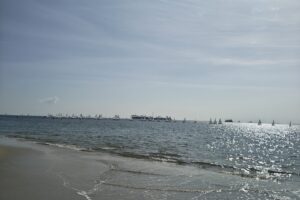Preserving Coastlines: Grooming Beaches or Letting Nature Take Its Course?
Beaches are among the most beloved and iconic natural environments on the planet, offering recreational opportunities, supporting wildlife, and serving as natural barriers that protect coastal communities. As human activity increasingly impacts coastlines, the question of how best to preserve these environments has sparked debate. One of the critical points of contention is whether to groom beaches—removing seaweed and debris and reshaping sand or letting nature take its course and allow beaches to function as dynamic, ever-changing ecosystems. Both approaches have their benefits and drawbacks, and finding the right balance is essential for the long-term health of coastlines and the communities that rely on them.
The Case for Beach Grooming
Beach grooming is a common practice, especially in areas that rely on tourism. Municipalities often groom beaches to make them more appealing and accessible to visitors by removing unsightly seaweed, trash, and other debris. In some cases, grooming can also involve redistributing sand to mitigate erosion or ensure the beach remains level and easy to walk on.
For many beachgoers, groomed beaches enhance the overall experience. They provide clean, smooth stretches of sand free from sharp rocks, tangled seaweed, and other debris that can make walking or sitting on the beach less comfortable. In tourist-heavy areas, maintaining pristine beaches is often crucial to attracting visitors and supporting the local economy. Grooming can also reduce the amount of harmful waste, like plastics and glass, which pose hazards to both people and marine life.
In addition to aesthetics and safety, beach grooming can serve an essential functional purpose in managing coastal erosion. By redistributing sand from areas of accumulation to eroded spots, grooming can temporarily shore up sections of the beach that might otherwise shrink or disappear altogether. This way, grooming can help protect beachfront property and infrastructure, preventing costly damage from storm surges and high tides.
The Case for Letting Nature Take Its Course
While beach grooming might seem like a solution to maintaining healthy coastlines, it has downsides. Many environmentalists argue that the practice disrupts the natural processes vital to coastal ecosystems’ health. Beaches are dynamic environments, constantly shaped by wind, waves, tides, and the movement of sand. When grooming interferes with these natural processes, it can do more harm than good.
One of the most significant concerns with beach grooming is its impact on biodiversity. Seaweed, for instance, might be viewed as unsightly by some, but it plays a crucial role in the coastal ecosystem. Seaweed on the shore provides food and shelter for various organisms, from insects and birds to small marine creatures. Removing it disrupts the food chain and can cause ripple effects throughout the ecosystem. Additionally, seaweed helps retain moisture in the sand, creating microhabitats essential for beach-dwelling species like crabs, turtles, and shorebirds.
Beach grooming can also accelerate erosion rather than prevent it. Natural beach dynamics, including dunes, driftwood, and plant material buildup, provide a buffer against rising sea levels and storm surges. When grooming removes these natural barriers, beaches can become more vulnerable to erosion. Without these protective features, sand is more easily washed away, exacerbating the problem that grooming is sometimes meant to solve.
Allowing beaches to remain natural also helps them adapt to environmental changes over time. As sea levels rise and weather patterns become more extreme due to climate change, natural beaches can shift and evolve in ways that make them more resilient. In contrast, groomed beaches, which are often artificially leveled or shaped, can become more fragile and less able to withstand the pressures of a changing climate.
Finding the Balance: A Sustainable Approach
The debate between grooming beaches and letting nature take its course doesn’t necessarily require choosing one option over the other. The most sustainable approach often lies somewhere in the middle, balancing human management and natural processes.
One solution is selective grooming, where only certain beach areas are maintained for recreational purposes, while other sections are left untouched to support wildlife and natural coastal processes. For example, highly trafficked tourist zones might require regular cleaning, while nearby dunes or less populated sections of the beach can remain in their natural state. This approach can minimize the environmental impact while still catering to the needs of local economies and beachgoers.
Another strategy is using natural debris management rather than complete removal. Instead of clearing all seaweed and driftwood, municipalities can implement practices that allow some organic material to remain on the beach, supporting ecosystems without compromising human use. In addition, communities can encourage beachgoers to participate in beach cleanups, focusing on removing harmful litter like plastics while leaving natural debris in place.
Finally, it’s crucial to invest in long-term coastal protection strategies that go beyond grooming. This includes dune restoration projects, the planting of native vegetation, and the implementation of policies that prevent overdevelopment near fragile coastlines. By taking a holistic approach to beach preservation, communities can protect both the environment and their livelihoods sustainably and forward-thinkingly.
Conclusion: Protecting Beaches for Future Generations
Whether to groom beaches or let nature take its course is a complex decision. Both approaches have their advantages and drawbacks, and the best solution depends on the specific needs of the beach and the community. However, what is clear is that preserving coastlines requires a thoughtful, balanced approach that considers both the environment and human interests. By finding sustainable ways to manage our beaches, we can ensure that these beautiful and vital ecosystems remain healthy and resilient for generations.





